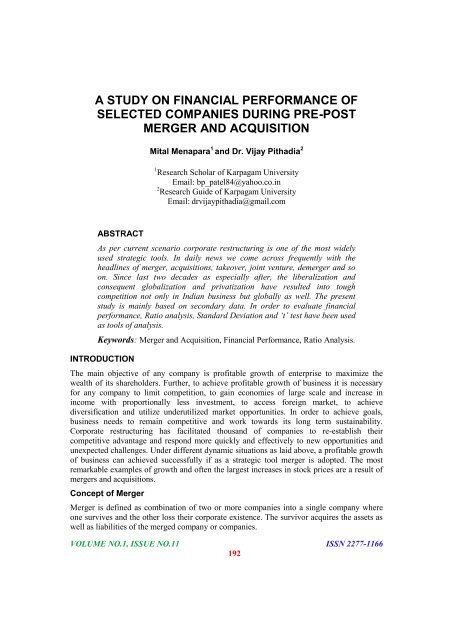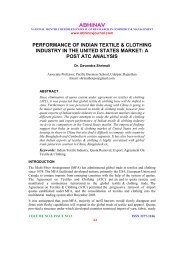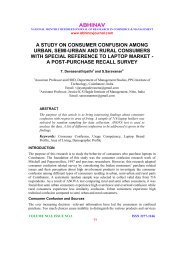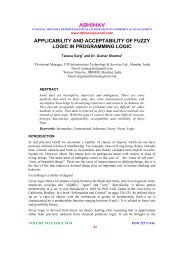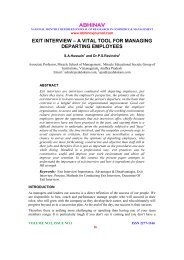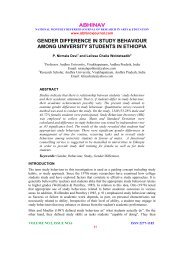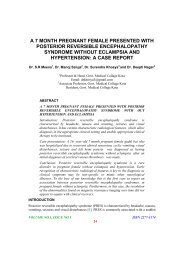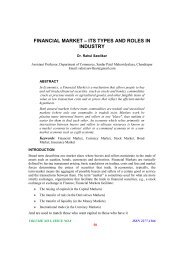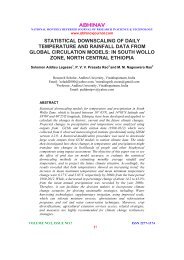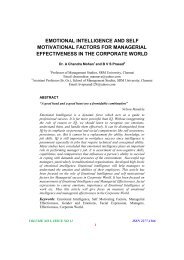A Study On Financial Performance Of Selected Companies During ...
A Study On Financial Performance Of Selected Companies During ...
A Study On Financial Performance Of Selected Companies During ...
You also want an ePaper? Increase the reach of your titles
YUMPU automatically turns print PDFs into web optimized ePapers that Google loves.
A STUDY ON FINANCIAL PERFORMANCE OF<br />
SELECTED COMPANIES DURING PRE-POST<br />
MERGER AND ACQUISITION<br />
Mital Menapara 1 and Dr. Vijay Pithadia 2<br />
1 Research Scholar of Karpagam University<br />
Email: bp_patel84@yahoo.co.in<br />
2 Research Guide of Karpagam University<br />
Email: drvijaypithadia@gmail.com<br />
ABSTRACT<br />
As per current scenario corporate restructuring is one of the most widely<br />
used strategic tools. In daily news we come across frequently with the<br />
headlines of merger, acquisitions, takeover, joint venture, demerger and so<br />
on. Since last two decades as especially after, the liberalization and<br />
consequent globalization and privatization have resulted into tough<br />
competition not only in Indian business but globally as well. The present<br />
study is mainly based on secondary data. In order to evaluate financial<br />
performance, Ratio analysis, Standard Deviation and ‘t’ test have been used<br />
as tools of analysis.<br />
Keywords: Merger and Acquisition, <strong>Financial</strong> <strong>Performance</strong>, Ratio Analysis.<br />
INTRODUCTION<br />
The main objective of any company is profitable growth of enterprise to maximize the<br />
wealth of its shareholders. Further, to achieve profitable growth of business it is necessary<br />
for any company to limit competition, to gain economies of large scale and increase in<br />
income with proportionally less investment, to access foreign market, to achieve<br />
diversification and utilize underutilized market opportunities. In order to achieve goals,<br />
business needs to remain competitive and work towards its long term sustainability.<br />
Corporate restructuring has facilitated thousand of companies to re-establish their<br />
competitive advantage and respond more quickly and effectively to new opportunities and<br />
unexpected challenges. Under different dynamic situations as laid above, a profitable growth<br />
of business can achieved successfully if as a strategic tool merger is adopted. The most<br />
remarkable examples of growth and often the largest increases in stock prices are a result of<br />
mergers and acquisitions.<br />
Concept of Merger<br />
Merger is defined as combination of two or more companies into a single company where<br />
one survives and the other loss their corporate existence. The survivor acquires the assets as<br />
well as liabilities of the merged company or companies.<br />
VOLUME NO.1, ISSUE NO.11 ISSN 2277-1166<br />
192
ABHINAV<br />
NATIONAL MONTHLY REFEREED JOURNAL OF REASEARCH IN COMMERCE & MANAGEMENT<br />
www.abhinavjournal.com<br />
Merger or amalgamation means “Combining of two commercial companies into one” and<br />
“Merging of two or more business concerns into one”. Merger is just one type of acquisition.<br />
<strong>On</strong>e company can acquire another in several other ways including purchasing some or all of<br />
the company’s assets or buying up its outstanding share of stock.<br />
Concept of Acquisition<br />
Acquisition in general sense is acquiring the ownership in the property. Acquisition is the<br />
purchase by one company of controlling interest in the share capital of another existing<br />
company. This means that even after the takeover although there is change in the<br />
management of both the firms retain their separate legal identity.<br />
REVIEW OF LITERATURE<br />
Merger and acquisition for long have been an important phenomenon in the US and UK<br />
economics. In India also, they have now become a matter of everyday occurrence. They are<br />
the subject of counting interest to different persons such as the business executives who are<br />
looking for potential merger partners, investment bankers who manage the mergers, lawyers<br />
who advice the parties, regulatory authorities concern with the operations of security market<br />
and growing corporate concentration in the economy and academic researchers who want to<br />
understand these phenomenon better.<br />
Gallet C.A (1996), “Merger and Market Power in the US Steel industry” He examine the<br />
relationship between mergers in the U.S. steel industry and the market power. The study<br />
employed New Empirical Industrial Organization (NEIO) approach which estimates the<br />
degree of market power from a system of demand and supply equations. The study analyzed<br />
yearly observations over the period between 1950 and 1988 and results have revealed that in<br />
the period of1968 to 1971 merges did not have a significant effect on market power in the<br />
steel industry; whereas mergers in 1978 and 1983 did slightly boost market power in the<br />
steel industry.<br />
Anup Agraval Jeffrey F. Jaffe (1999), “The Post-merger <strong>Performance</strong> Puzzle” they examines<br />
the literature on long-run abnormal returns following mergers. The paper also examines<br />
explanations for any findings of underperformance following mergers. We conclude that the<br />
evidence does not support the conjecture that underperformance is specifically due to a slow<br />
adjustment to merger news. We convincingly reject the EPS myopia hypothesis, i.e. the<br />
hypothesis that the market initially overvalues acquirers if the acquisition increases EPS,<br />
ultimately leading to long-run under-performance.<br />
Saple V. (2000), “Diversification, Mergers and their Effect on Firm <strong>Performance</strong>: A <strong>Study</strong> of<br />
the Indian Corporate Sector” he finds that the target firms were better than industry averages<br />
while the acquiring firm shad lower than industry average profitability. Overall, acquirers<br />
were high growth firms which had improved the performance over the years prior to the<br />
merger and had a higher liquidity.<br />
Beena P.L (2000), ‘An analysis of merger in the private corporate sector in India’ she<br />
attempts to analyze the significance of merger and their characteristics. The paper establishes<br />
that acceleration of the merger movement in the early 1990s was accompanied by the<br />
dominance of merger between firms belonging to the same business group of houses with<br />
similar product line.<br />
VOLUME NO.1, ISSUE NO.11 ISSN 2277-1166<br />
193
ABHINAV<br />
NATIONAL MONTHLY REFEREED JOURNAL OF REASEARCH IN COMMERCE & MANAGEMENT<br />
www.abhinavjournal.com<br />
Vardhana Pawaskar (2001), “Effect of Mergers on Corporate <strong>Performance</strong> in India” he<br />
studied the impact of mergers on corporate performance. It compared the pre- and postmerger<br />
operating performance of the corporations involved in merger between 1992 and<br />
1995 to identify their financial characteristics. The study identified the profile of the profits.<br />
The regression analysis explained that there was no increase in the post- merger profits. The<br />
study of a sample of firms, restructured through mergers, showed that the merging firms<br />
were at the lower end in terms of growth, tax and liquidity of the industry. The merged firms<br />
performed better than industry in terms of profitability.<br />
Paul (2003) “The merger of Bank of Madura with ICICI Bank”. The researcher evaluated the<br />
valuation of the swap ratio, the announcement of the swap ratio, share price fluctuations of<br />
the banks before the merger decision announcement and the impact of the merger decision<br />
on the share prices. He also attempted the suitability of the merger between the 57 year old<br />
Bank of Madura with its traditional focus on mass banking strategies based on social<br />
objectives, and ICICI Bank, a six year old ‘new age’ organisation, which had been<br />
emphasizing parameters like profitability in the interests of shareholders. It was concluded<br />
that synergies generated by the merger would include increased financial capability, branch<br />
network, customer base, rural reach, and better technology. However, managing human<br />
resources and rural branches may be a challenge given the differing work cultures in the two<br />
organizations.<br />
Joydeep Biswas (2004) “ Recent trend of merger in the Indian private corporate sector”.<br />
They research about Corporate restructuring in the form M&A has become a natural and<br />
perhaps a desirable phenomenon in the current economic environment. In the tune with the<br />
worldwide trend, M&A have become an important conduit for FDI inflows in India in recent<br />
years. In this paper it is argued that the Greenfiled FDI and cross-border M&As are not<br />
alternatives in developing countries like India.<br />
Vanitha. S (2007) “Mergers and Acquisition in Manufacturing Industry” she analyzed the<br />
financial performance of the merged companies, share price reaction to the announcement of<br />
merger and acquisition and the impact of financial variables on the share price of merged<br />
companies. The author found that the merged company reacted positively to the merger<br />
announcement and also, few financial variables only influenced the share price of the merged<br />
companies.<br />
Vanitha. S and Selvam. M (2007) “<strong>Financial</strong> <strong>Performance</strong> of Indian Manufacturing<br />
<strong>Companies</strong> during Pre and Post Merger” they analyzed the pre and post merger performance<br />
of Indian manufacturing sector during 2000-2002 by using a sample of 17 companies out of<br />
58 (thirty percent of the total population). For financial performance analysis, they used ratio<br />
analysis, mean, standard deviation and ‘t’ test. They found that the overall financial<br />
performance of merged companies in respect of 13 variables were not significantly different<br />
from the expectations.<br />
Kumar (2009), "Post-Merger Corporate <strong>Performance</strong>: an Indian Perspective" examined the<br />
post-merger operating performance of a sample of 30 acquiring companies involved in<br />
merger activities during the period 1999-2002 in India. The study attempts to identify<br />
synergies, if any, resulting from mergers. The study uses accounting data to examine merger<br />
related gains to the acquiring firms. It was found that the post-merger profitability, assets<br />
VOLUME NO.1, ISSUE NO.11 ISSN 2277-1166<br />
194
ABHINAV<br />
NATIONAL MONTHLY REFEREED JOURNAL OF REASEARCH IN COMMERCE & MANAGEMENT<br />
www.abhinavjournal.com<br />
turnover and solvency of the acquiring companies, on average, show no improvement when<br />
compared with pre- merger values.<br />
OBJECTIVES OF THE STUDY<br />
The broad objective of this study is to measure the impact of mergers and acquisitions on<br />
financial <strong>Performance</strong> of Indian Corporate Sectors. Other objectives of the study are<br />
mentioned as under. To examine and evaluate the impact of merger and acquisitions on<br />
Return on Investment, Profitability and Liquidity position of selected companies.<br />
RESEARCH METHODOLOGY<br />
Data Collection<br />
The study is based on the secondary data taken from the annual reports of selected units. And<br />
all the data relating to history, growth and development of Industries have been collected<br />
mainly from the books and magazine relating to the industry and published paper, report,<br />
article and from the various news papers, bulletins and other various research reports<br />
published by industry and various websites.<br />
Selection of Samples<br />
The study has been carried out on the micro-level, as it is not possible for the researcher to<br />
conduct it on the macro-level. The population of the study consists of all types of the<br />
companies having different operations of business and totally different nature of industries.<br />
As the study is to be carried out by the individual researcher it is not easy to select all the<br />
companies as the samples for the study. So, selection based upon growth aspect of<br />
companies from Indian industry in present scenario.<br />
Period of the <strong>Study</strong><br />
The present study is mainly intended to examine the financial performance of merged<br />
companies five years before merger and five years after merger.<br />
Hypothesis of the <strong>Study</strong><br />
<strong>On</strong> the basis of data collection, the researcher identified the following broader hypothesis for<br />
the study:<br />
Null Hypothesis<br />
There would be no significant difference in means score of <strong>Financial</strong> <strong>Performance</strong> in<br />
selected units, before and after merger and acquisition.<br />
Alternate Hypothesis<br />
There would be significant difference in means score of <strong>Financial</strong> <strong>Performance</strong> in selected<br />
units, before and after merger and acquisition.<br />
TOOLS OF ANALYSIS<br />
Data Analysis<br />
Pre-merger and post-merger performance ratios were estimated and the averages computed<br />
for the selected units, during five years before merger and five years after merger. Average<br />
VOLUME NO.1, ISSUE NO.11 ISSN 2277-1166<br />
195
ABHINAV<br />
NATIONAL MONTHLY REFEREED JOURNAL OF REASEARCH IN COMMERCE & MANAGEMENT<br />
www.abhinavjournal.com<br />
pre-merger and post-merger financial performance ratios were compared to see if there was<br />
any statistically significant change in financial performance due to mergers, using Student<br />
paired “t” distribution test.<br />
Ratio Analysis<br />
Ratios are among the well known and most widely used tools of financial analysis. Ratio can<br />
be defined as “The indicated quotient of two mathematical expression”. 16 an operational<br />
definition of ratio is the relationship between one item to another expressed in simple<br />
mathematical form.<br />
T-test Analysis<br />
T – Test is based on T – Distribution and is considering an appropriate test for judging the<br />
significance of a sample mean. It can also be used for judging, the significance of the<br />
coefficients of simple and partial correlations.<br />
The relevant test statistic, is calculated from the sample data and then compared with its<br />
problem value based on T – distribution at a specified level of significance for concerning<br />
degrees of freedom for accepting or rejecting the Null Hypothesis.<br />
<strong>Financial</strong> Analysis<br />
No. Ratio Mean (D) S.D.() t c t t Result<br />
01 EPS -0.255 14.34 0.056 2.262 H 0<br />
02 GPR -1.111 5.63 0.624 2.262 H 0<br />
03 NPR -2.644 4.43 1.889 2.262 H 0<br />
04 ROGCE 2.637 3.85 2.168 2.262 H 0<br />
05 RONCE -3.835 5.53 2.268 2.262 H 1<br />
06 ROSHFUNDS -6.069 9.60 1.999 2.262 H 0<br />
07 ROLTFUNDS -4.253 10.99 1.224 2.262 H 0<br />
In the above table, the researcher has calculated averages, standard deviation of different<br />
ratios like Return on gross capital employed, Return on net capital employed, Return on<br />
shareholder’s funds, Return on long term funds, Earning per share, Gross profit ratio, Net<br />
profit ratio, and Operating profit ratio for five years before merger and five years after the<br />
merger for selected units.<br />
Ho = μ 1 = μ 0 H1 = μ 1 ≠ μ 0.<br />
In the above table the researcher has calculated the T-test for different ratios. In majority of<br />
cases the calculated value of ‘T’ is lower than the tabulated value of ‘T’, which means that<br />
there is no significant effect of merger and acquisition on the financial performance of<br />
selected units but in the case of operating profit ratio and earning per share ratio of Exide<br />
Industry the calculated value of ‘T’ is higher than the tabulated value of ‘T’, that means there<br />
is significant effect of merger and acquisition on operating profit and earnings per share of<br />
Exide Industry. From the above table it can be stated that there is no any significant effect of<br />
merger and acquisition on ROGCE, ROSHFUNDS, ROLTFUNDS, EPS, GPR, NPR, and<br />
OPR. But there is a significant effect of merger and acquisition on RONCE.<br />
VOLUME NO.1, ISSUE NO.11 ISSN 2277-1166<br />
196
ABHINAV<br />
NATIONAL MONTHLY REFEREED JOURNAL OF REASEARCH IN COMMERCE & MANAGEMENT<br />
www.abhinavjournal.com<br />
LIMITATION OF THE STUDY<br />
Every live and non-live factor has its own limitations which restrict the usability of that<br />
factor. The same rule applies to this research work. The major limitations of this study are as<br />
under:<br />
<br />
<br />
<br />
<br />
This study is mainly based on secondary data derived from the annual reports of<br />
industry. The reliability and the finding are contingent upon the data published in<br />
annual report.<br />
The study is limited to five years before merger and five years after merger only.<br />
Accounting ratios have its own limitation, which also applied to the study.<br />
This study is related with ten units. Any generalization for universal application<br />
cannot be applied here.<br />
<strong>Financial</strong> analysis do not repict those facts which cannot be expressed in terms of money, for<br />
example – efficiency of workers, reputation and prestige of the management<br />
CONCLUSION<br />
It is evident from the above analysis both the hypothesis are not fully accepted. The<br />
conclusion emerging from the point of view financial evaluation is that the merging<br />
companies were takeover by companies with reputed and good management. Therefore, it<br />
was possible for the merged firms to turnaround successfully in due course. However it<br />
should be tested with a bigger sample size before coming to a final conclusion.<br />
LIST OF ABBREVIATION<br />
EPS - Earning Per Share<br />
GPR - Gross Profit Ratio<br />
NPR - Net Profit Ratio<br />
ROGCE - Return on Gross Capital Employed<br />
RONCE - Return on Gross Capital Employed<br />
ROSHFUNDS - Return on Share Holders Fund<br />
ROLTFUNDS - Return on Long – Term Funds<br />
REFERENCES<br />
1. Gallet, C. A., (1996). “Mergers and Market Power in the U.S. Steel Industry” Applied<br />
Economics Letters 3, Page No. 221-223.<br />
2. Anup Agrawal Jeffrey F. Jaffe (1999), “The Post-merger <strong>Performance</strong> Puzzle”, Journal<br />
of Corporate Finance, USA Saple (2000), “Diversification, Mergers and their Effect on<br />
Firm <strong>Performance</strong>: A <strong>Study</strong> of the Indian Corporate Sector”, Unpublished Ph.D. thesis<br />
submitted to IGIDR, Mumbai.<br />
3. Beena P. L. (2000). ‘An analysis of merger in the private corporate sector in India’<br />
Journal of Scientific & Industrial Research, Special Issue on Management, August –<br />
Sep., Nasscom, New Delhi. Page No. 34-51<br />
VOLUME NO.1, ISSUE NO.11 ISSN 2277-1166<br />
197
ABHINAV<br />
NATIONAL MONTHLY REFEREED JOURNAL OF REASEARCH IN COMMERCE & MANAGEMENT<br />
www.abhinavjournal.com<br />
4. Saple V. (2000) “”“Diversification, Mergers and their Effect on Firm <strong>Performance</strong>: A<br />
<strong>Study</strong> of the Indian Corporate Sector”, Review of Quantitative Finance and Accounting.<br />
Page No.67.<br />
5. Vardhana Pawaskar, 2001. Effect of Mergers on Corporate <strong>Performance</strong> in India.<br />
Vikalpa, 26 (1):Page No19-32<br />
6. Paul (2003) “merger of Bank of Madura with ICICI Bank” Journal of Banking and<br />
Finance 17, Page No. 411-422.<br />
7. Yuce, A. and A. Ng.(2005). "Effects of Private and Public Canadian Mergers", Journal<br />
of Administrative Sciences, June, Page No. 111-124.<br />
8. Vanitha, S. 2006. Mergers and Acquisitions in the Manufacturing Sector: An Evaluation<br />
<strong>Study</strong>, PhD Dissertation, Bharathidasan University, Tiruchirappalli.<br />
9. Vanitha, S. and M. Selvam, 2007. <strong>Financial</strong> <strong>Performance</strong> of Indian Manufacturing<br />
<strong>Companies</strong> during Pre and Post Merger. International Research Journal of Finance and<br />
Economics,Page No12:7-35<br />
10. Kumar, R., (2009). "Post-Merger Corporate <strong>Performance</strong>: an Indian Perspective",<br />
Management Research News 32 (2), Page No. 145-157.<br />
11. P. Mohan Rao (1990) “Merger and Acquisitions of companies” “Deep & Deep<br />
publication pvt. Ltd. Page No.152.<br />
12. N.R. sridharan and P.H. Arvind Pandian (1992), “Guide to takeovers and Mergers”<br />
Nagpur wadhwa Publication Pvt Ltd. Nagpur. Page No.23.<br />
13. Mueller, Dennis (1980), “The Determinants and Effects of Mergers: An International.<br />
Cambridge University Press. Page No. 87<br />
14. Oelgeschlager, Gunn and Hain. Mueller, Dennis (1984), “Mergers and Market Share”,<br />
Review of Economics. Cambridge University Press. Page No. 51<br />
15. Mueller, Dennis (1987), “The Corporation: Growth, Diversification and Mergers”,<br />
Statistics, Vol. 67, May, University of Maryland, USA. Page No. 259-267.<br />
16. Beena P. L. (2000). ‘An analysis of merger in the private corporate sector in India’<br />
Journal of Scientific & Industrial Research, Special Issue on Management, August –<br />
Sep., Nasscom, New Delhi. Page No. 34-51<br />
17. Andre, P., M. Kooli and J. L’Her, (2004). “The Long-Run <strong>Performance</strong> of Mergers and<br />
Acquisitions: Evidence from the Canadian Stock Market”, <strong>Financial</strong> Management 33 (4),<br />
Page No.27-43.<br />
18. P. M. Healy, K.G. Palepu, and R. S. Ruback, (1992) “Does Corporate <strong>Performance</strong><br />
19. Improve After Mergers ”, Journal of <strong>Financial</strong> Economics, Vol 31, Page No. 135- 175<br />
20. Lubatkin, M., (1983): 'Mergers and <strong>Performance</strong> of the Acquiring Firm', Academy of<br />
Management Review, Vol. 8, No. 2, April, Page No. 218-225<br />
VOLUME NO.1, ISSUE NO.11 ISSN 2277-1166<br />
198


